The Cold Email Masterclass
Lesson 6
Follow-Up Emails
[lyte id=”BBGr4BHNQk0″ /]

If you’re short on time, I’ll save you a step. All you need to know about follow up emails is this:
Follow up emails are effective, and your cold sales email campaign needs to have them.
Want more? Here’s what makes them so effective, as well as my best tips on deploying them successfully.
Why Follow Up Emails?
Intuitively, you probably already know the answer to this. But let’s back our instincts up with data:
- 92% of salespeople give up after four “no’s”, but 80% of prospects say “no” four times before they say “yes”. (MTD Sales Training)
- Research shows that 35% to 50% of sales go to the vendor that responds first. (MTD Sales Training)
- You have a 21% chance of getting a reply to your second email if the first goes unanswered. (Yesware)
The following chart from Yesware shows just how effective follow up emails can be, with senders receiving responses after as many as 10 separate follow up messages: (image source: Yesware)
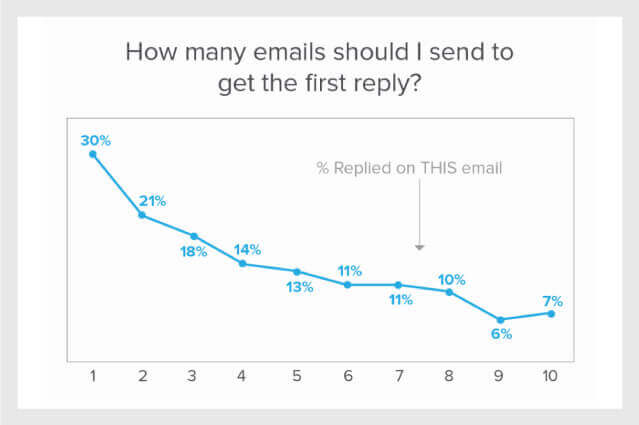
How Often Should You Send Follow Up Emails?
Ten follow up emails might feel excessive to you. It does to me – I tend to stop after three.
That said, there are as many opinions on the topic as there are senders of cold emails. To help you find the follow up schedule that’s right for you, I rounded up suggestions from three top salespeople:
“If you reach out completely cold and never had any interaction with the other person, follow up a maximum of six times. You really don’t have the type of relationship that gives you permission to do much more than that.
If you already had some kind of interaction and that interaction was not a clear, definite NO, then follow up as long as it takes to get a response. Never stop till you get a response.”
Steli Efti, close.io
“Persistently emailing your prospects with a valuable and interesting message ultimately overshadows the effect of timing, especially if you vary the timing of emails throughout the campaign.”
Heather Morgan, Salesfolk
In one example, Heather describes her company’s engagement with tech startup Ambition. To improve response rates to cold emails, her team devised a sequence of eight follow up messages for each of the team’s two buyer personas.
The best performing message? #6B. According to Heather:
“While email #6’s performance may partially be a result of how persuasive and effective this particular email copy was, this coincides with the classic sales lesson that persistence works for email.”
Eric invested in follow up emails after realizing his cold email response rates were, in his words, “an abysmal 3%”. After adding a 5-step automated follow up sequence to his cold emails, he was able to achieve a 83% open rate and a 13% response rate.
“Sometimes you just need a swift kick in the butt to get you back on track. After auditing our processes, adjusting our templates and automating our follow-ups, we got the results that we were looking for.”
Eric Siu, Growth Everywhere
Still not sure where your company should fall on the follow up spectrum? Here’s a general rule of thumb to keep in mind: You’re representing your brand with every message you send. Be persistent, but not so aggressive that you diminish your brand’s value.
How to Write a Good Follow Up Email
Now that you know you need a follow up email (or, even better, a series of them), what should you put in them?
While there’s no universal solution for follow up success, there are a few principles to keep in mind that’ll steer you in the right direction:
Add More Value
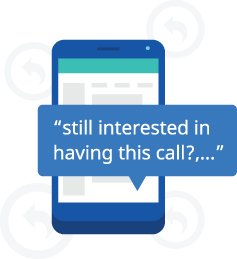
If you didn’t get an initial response, try something like “Still interested in having this call? By the way, I thought of you with these two articles.”
Don’t assume that people aren’t interested in talking to you, just because they didn’t respond to your first message. Assume they’re busy, and that it’s up to you to figure out what value they need to see in order to engage.
Dial Down Your Ask
If you initially asked to setup a free consultation call, test whether or not you have better luck asking for a lead magnet opt-in, for example.
Test a Different Pitch or CTA Entirely
Maybe your prospect isn’t looking for a new SaaS provider at the time. But they may still be interested in your bespoke consulting services.
Get them on the line for one product or service, and selling others becomes easier once they’re onboard.
Avoid Filler Expressions
“Hey, I just wanted to…” or “I just wanted to follow up…” won’t get you responses.
Follow the same suggestions above for keeping your email copy tight and focused on your prospect’s needs – not on your need to make a sale.
Be Funny, Not Gimmicky
Here’s an example of a funny follow up message, courtesy of Steli Efti: (image source: close.io)
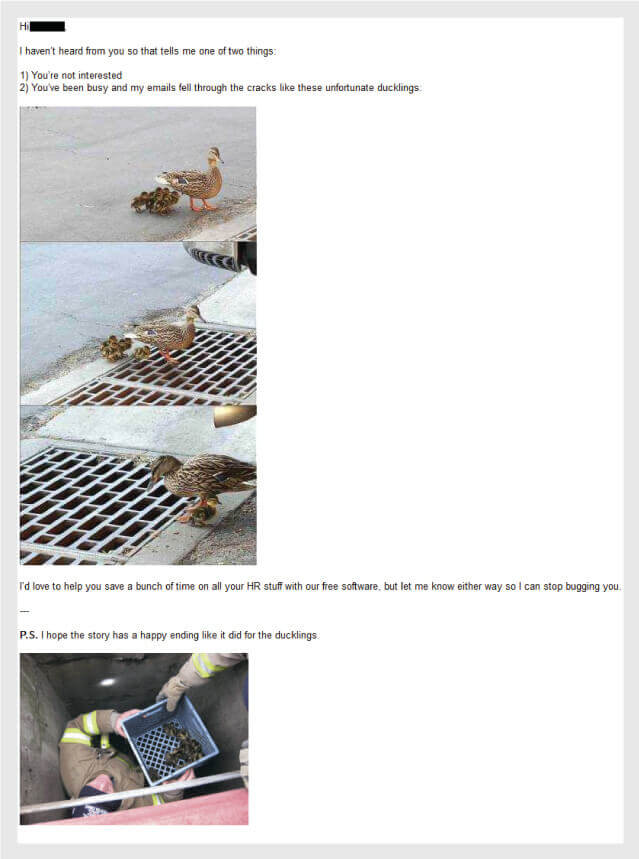
And here’s an example of a gimmicky follow up message, thanks to NextGen Leads: (image source: NextGen Leads)
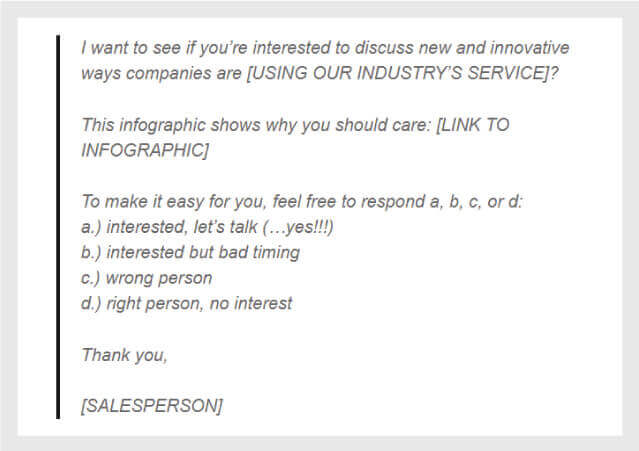
This isn’t grade school. Don’t ask your prospects to take multiple choice quizzes or to check “yes” or “no” on whether they like you.
The line between funny and gimmicky is a difficult one to walk. If you aren’t confident your follow ups will be received as clever, not creepy, stick to messages that are purely professional.
Test, Test and Test Some More
Test as many variables in your follow up emails as you do your initial cold messages. In particular:
- Test different templates
- Test different message formats
- Email at a different time of day
- Test the number of follow up messages you send
Continually iterate your follow up sequence to increase your ultimate odds of success.
Automating Your Cold Email Follow Up
As with your initial cold emails, your follow up sequences can be automated to save you the time and energy of sending manual messages.
Automating follow up messages comes with its own caveats, however, as there are unique challenges associated with sending full series of emails on autopilot.
For instance, what happens if prospects on your list receive duplicate follow ups, as Capterra’s Caroline Malamut did after attending a conference: (image source: Capterra)
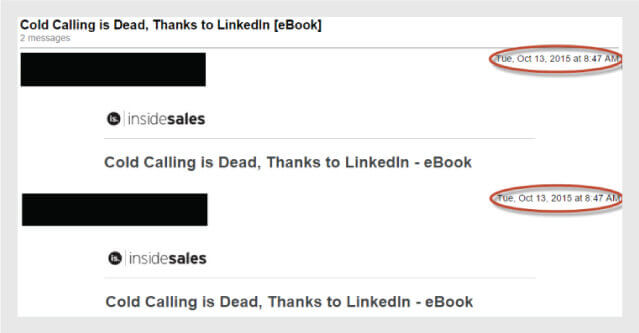
There’s also the risk that past interactions you’ve had with a prospect won’t be reflected in the follow up sequence, as happened to Yesware’s Elise Musumano: (image source: Yesware)
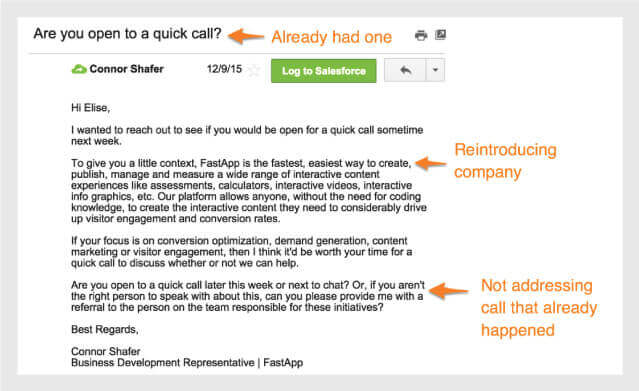
Before launching an automated follow up series, ask yourself the following questions:
- Do I have the technical know-how to setup and manage a drip sequence?
- Are my custom/personalization fields pulling the right information?
- Have I optimized my follow-up templates before adding them to a sequence?
- Does my sequence timing take weekends, holidays, etc into consideration?
- Will my automated follow-ups be sorted with my original email in prospects’ inboxes?
- Will prospects who respond be taken out of follow-up sequence?
It’s also worth reviewing the following tips on deliverability to ensure your follow up messages make it to the intended recipients – especially given that 21% of opt-in emails never make it to the inbox:

- Choose a reputable drip campaign sender with a track record of high deliverability
- Practice good data hygiene by verifying any emails you’ve scraped (using a tool like VoilaNorbert) and scrubbing any addresses that bounce
- Avoid words that trigger spam filters
- Don’t include too many images or links, relative to the amount of text you’ve included
- Send consistent volumes at consistent times
- Customize the text associated with your links (as leaving the raw URL as is can cause mismatches between the printed link and the tracked link the user gets, which spam filters don’t like)
Keep the Golden Rule in mind to avoid spam complaints. If you wouldn’t want to receive the follow up messages you’ve drafted, don’t send them unto others.
Great Examples of Follow Up Messages
Get inspired to put the tips and tricks described above into practice with the following examples:
FullStory
Remember the personalized cold email from FullStory I shared in Lesson #4? Here it is again as a reminder: (image source: Proposify)
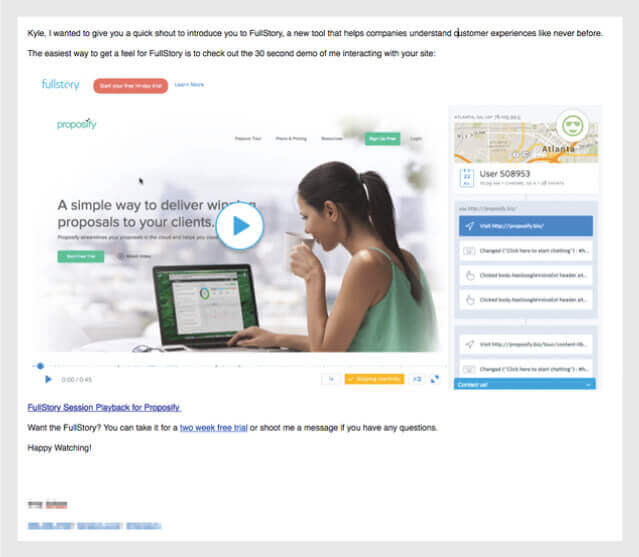
Here’s where the story gets even better… This is the follow up message sent from FullStory after Proposify’s Kyle viewed the personalized demo: (image source: Proposify)

Why It Works
FullStory’s follow up is successful because it’s triggered by an action (in this case, watching the demo). FullStory knows it should follow up (and can likely do so effectively) because it’s detected that the recipient took a specified engagement action.
Breakthrough Email
Hubspot shares the following example of a simple, yet effective cold email follow up message, written by Bryan Kreuzberger of Breakthrough Email:

Why It Works
Though the message isn’t anything complex, it gets to the point quickly, is respectful of the recipient’s time and includes an extremely low-friction ask.
Perhaps that’s why it led to an 80% email open rate and $4,386,000 in additional revenue.
Klenty
Sales prospecting solution Klenty shares the following example of an effective follow up template:
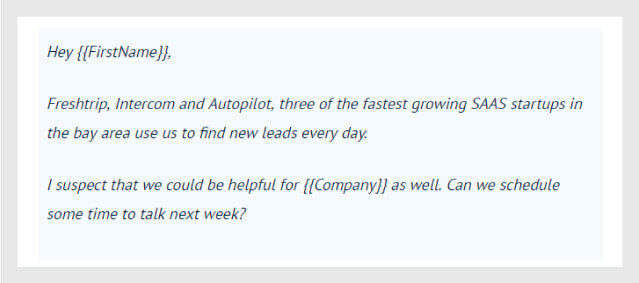
Why It Works

Klenty’s template leverages the power of social proof, which, OptinMonster’s Mary Fernandez notes, can be used “as a tactic for increasing conversions by easing the minds of worried customers.” Anything you can do to diminish prospects’ resistance helps – and, in this case, social proof absolutely does the job.
As you’re probably sick of hearing me say by this point, there’s no certainty when it comes to cold emailing – follow up messages included.
Use the suggestions and sample messages here as a baseline for your campaigns, but then test different iterations based on your unique circumstances.
And speaking of testing…